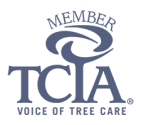Call the Tree Care Pros
Crane Assisted Tree Removal
Removing trees with the assistance of a crane is hands down the best way to do it. Traditional tree removal methods are often time consuming and labor intensive. They require complex rigging and lowering to avoid obstacles and usually have inferior results compared to the crane assisted tree removal process. When a crane is used in the tree removal process it greatly reduces the amount of time that it takes to remove the tree and it also decreases the impact to the surroundings. When using a crane we are able to provide a safe and efficient no impact tree removal at a lower cost than traditional methods.
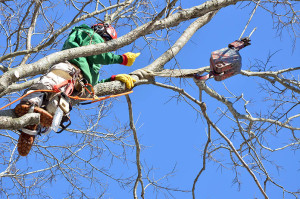
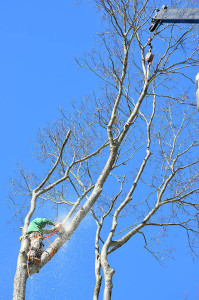
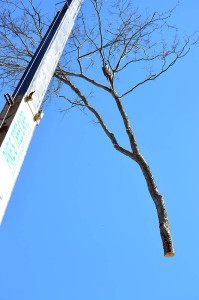
Cranes are the best invention since the Chainsaw in our industry. They have been utilized by tree services for decades but have become increasingly more popular over the past 20 years. Although very popular to use, It’s not common for a tree service to own and operate a crane, due to the cost. Pike’s Tree Care is proud to own and operate our cranes.
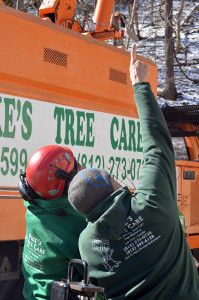
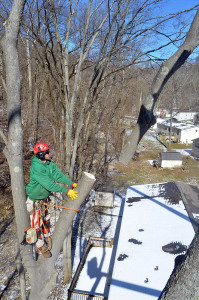
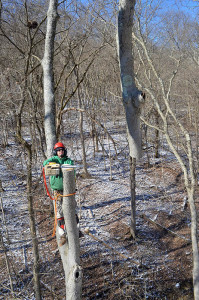
All of our Crane operators go through an extensive training process. Plain and simple,It takes skills, you have to be a great operator. But it doesn’t just stop there for our operators. Removing trees with a crane is half art and half science. No two trees are alike and each individual tree has to be handled differently.
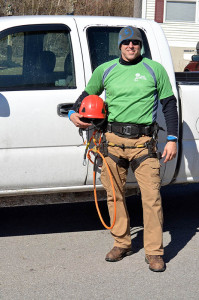
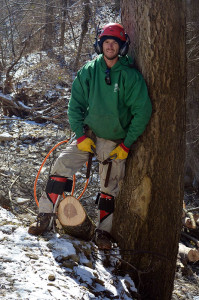
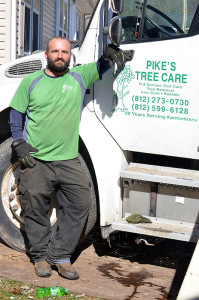
Tree Pruning and Trimming
We love and respect trees. From the mightiest oak to the tiniest dogwood we love them all. Yes even the Sweetgums and Honey Locusts.
Did you know that tree pruning increases the life expectancy of a tree and reduces the chances of branch and whole tree failure?
Tree pruning is the most common tree maintenance procedure and can be extremely beneficial. Because it is so common its importance can be overlooked. In a forested environment trees grow nicely with only Mother nature’s pruning. But trees in urban environments require more care and attention. Periodic pruning and trimming is essential for these urban trees. Pruning is necessary to maintain structural integrity and improve aesthetics and must be done by an individual that understands the biology and physiology of a tree. Improper pruning procedures can create lasting damage and shorten the tree’s life expectancy. Each cut that is made has the potential to change the growth pattern of the tree and just a single mistake can ruin the entire tree.

Pike’s Tree Care is dedicated to providing proper pruning. First and foremost we will always keep the trees health in mind. Prior to pruning, ask the arborist will examine the crown of the tree and identify which branches need to be removed. While pruning to meet the trees current needs we will also keep the trees future growth in mind. We understand how trees grow and what influences their growth patterns so we are able to redirect future growth the direction we want it to go.
There are many reasons for pruning trees.
We prune for safety, we prune for aesthetics, we prune trees to increase clearance.
Raising and elevating is the most common type of pruning that we are asked to perform. This type of pruning typically removes the lower branches from a tree to provide clearance for buildings, medical vehicles and pedestrians. It also includes reducing the spread of a tree to provide additional lateral clearance to buildings.
Cleaning is the general process for pruning and trimming trees. It is the removal of dead, dying, diseased, crossing, poorly attached, and unhealthy branches from the crown of a tree.
Thinning is the process of selectively removing branches to improve the structure of a tree and to increase light penetration and air movement through the crown. Proper thinning opens the foliage of a tree, reduces weight on heavy limbs, and helps retain the tree’s natural shape. Thinning should be concentrated on the outer portions of the canopy, leaving as many branches on the interior crown as possible.
Reduction reduces the size of a tree, often for utility line clearance. Reducing a tree’s height or spread is best accomplished by pruning back the leaders and branch terminals to secondary branches that are large enough to assume the terminal roles (at least one-third the diameter of the cut stem). Compared to topping, reduction helps maintain the form and structural integrity of the tree. This is the most common approach to pruning Bradford pear trees.
Stump Grinding
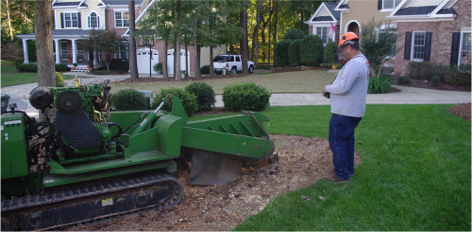 Stump grinding is usually the final step in the tree removal process. Typically the tree removal crew will leave the remaining stump 4-6 inches above the ground for the stump grinder to take care of. Stump grinders come in all shapes and sizes. Some stump grinders have tracks and some have wheels. Some stump grinding machines are operated via a remote control and some are operated by handles on the machine. All stump grinders use the same process for grinding. There is a rotating cutting wheel on the front of the machine that has carbide teeth attached to it. Once the Stump grinder is maneuvered into place the wheel will be engaged and the grinding will commence.
Stump grinding is usually the final step in the tree removal process. Typically the tree removal crew will leave the remaining stump 4-6 inches above the ground for the stump grinder to take care of. Stump grinders come in all shapes and sizes. Some stump grinders have tracks and some have wheels. Some stump grinding machines are operated via a remote control and some are operated by handles on the machine. All stump grinders use the same process for grinding. There is a rotating cutting wheel on the front of the machine that has carbide teeth attached to it. Once the Stump grinder is maneuvered into place the wheel will be engaged and the grinding will commence.
Once engaged the cutter wheel will work back and forth over the stump. It will grind about 2 inches at a time. The typical stump will be ground to a depth of 6-8 inches below the grade.
After the stump grinding process is done, you will have a pile of mulch that can either be left or hauled away depending on what you told the sales staff.
Cabling and Bracing
Cabling
Tree cabling is used to support a tree that has a structural defect, such as a co-dominant union, crack, cavity or other aggravating factor. When wind pushes against the upper portions of the canopy it significantly increases the amount of force and stress on the weak area, and could cause it to fail. Cabling prevents the increased force by securing the portions of the tree to others.
There are two basic types of cabling systems.
Static Cabling—Extra High strength (EHS) steel cable that has no give and is used in static systems. The cable is usually fastened to the tree with steel eye hooks, lag bolts or wire stops. Static systems are usually installed when little to no movement of the crown is desired. 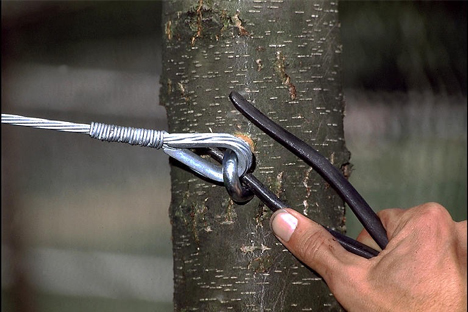 The first step in installing a static cabling system is determining the exact point where the cables will be installed. Supplemental support cables are installed 2/3–3/4 of distance between the crotch and the top of the tree or the end of the branch. After the location is determined the fasteners are installed. There are three common types of fasteners. Eye bolts, threaded lag hooks and wire stops. We prefer the wire stop connectors. If a through eye bolt or wire stop is used a hole must be drilled and the rod or wire inserted. If lag hooks are the type of anchor used they can simply be screwed into the tree. The cable will be measured cut and installed once the holes are drilled. Dynamic Cabling—Dynamic systems use a braided specialty rope with elastic qualities to allow for movement. As trees move with the wind they build more wood. Dynamic systems are a great proactive system to prevent failure but may not be the best for mitigating a tree that has already began to fail.
The first step in installing a static cabling system is determining the exact point where the cables will be installed. Supplemental support cables are installed 2/3–3/4 of distance between the crotch and the top of the tree or the end of the branch. After the location is determined the fasteners are installed. There are three common types of fasteners. Eye bolts, threaded lag hooks and wire stops. We prefer the wire stop connectors. If a through eye bolt or wire stop is used a hole must be drilled and the rod or wire inserted. If lag hooks are the type of anchor used they can simply be screwed into the tree. The cable will be measured cut and installed once the holes are drilled. Dynamic Cabling—Dynamic systems use a braided specialty rope with elastic qualities to allow for movement. As trees move with the wind they build more wood. Dynamic systems are a great proactive system to prevent failure but may not be the best for mitigating a tree that has already began to fail.

Bracing
Bracing is usually done in close proximity to the crotch or union. It is a straight forward process. The first step is to determine the number and size of the rods needed to properly support the weight of the stressed parts. If the tree has a significant amount of separation a come- along or other tensioning device will be used to close the crack. Once that is done, holes will be drilled all the way through the trunk(s). The holes are usually 1/16 inch smaller than the rod that will be installed this will ensure a snug fit. After the holes are drilled, the threaded steel rod will be inserted all the way through the trunk(s) and secured with washers and nuts. Cabling is often done in conjunction with bracing.
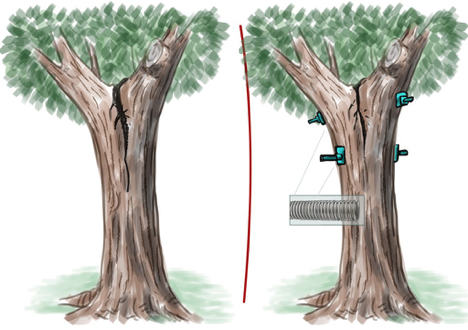
Spraying and Micro-Injection
Spraying
Spraying trees is just what it sounds like, a high powered sprayer is used to coat a tree or trees to treat them for a disease or a pest that is attacking them. Just like a human, trees can be affected by thousands of different infections, viruses, or external pests. Diagnosing the ailment of a tree is what we specialize in. Wether it be a benign treatment, like a dormant oil spray, or a more aggressive pesticide, insecticide, or fungicidal spray; we can recommend a treatment for your trees overall well-being.
Micro-Injection
While not new, micro-injection treatments are an advanced way of treating a tree for a variety of problems or to encourage overall tree health. Micro-injection is like an I V for your tree. It involves drilling tiny holes at the base of a tree and inserting a needle under the bark. The selected treatment is then injected directly into the cambium layer (the bloodstream) of the tree and carried throughout the entire tree by the phloem and xylem (vein and arteries). For pests like the Emerald Ash Borer this is by far the most effective way to treat. It delivers the pesticide (medicine) directly to the pest you are trying to eliminate without killing all of the other good external insects that call a tree home.
Get in touch.
Request a quote or send us a message below.
Proud member of:
